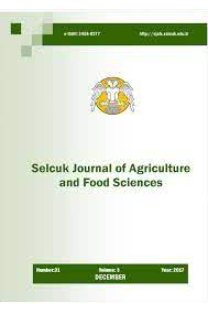Inhibitory Effect of Oregano and Laurel Essential Oils and Their Main Components on Seed Germination of Some Weed and Crop Species
Inhibitory Effect of Oregano and Laurel Essential Oils and Their Main Components on Seed Germination of Some Weed and Crop Species
Essential oil Germination, Laurel, Oregano, Weed seeds,
- ISSN: 2458-8377
- Yayın Aralığı: Yılda 3 Sayı
- Başlangıç: 2002
Molecular Characterization of Thripidae (Thysanoptera) Species in Karaman, Konya and Mersin (Turkey)
İnci ŞAHİN NEGİŞ, Cengiz İKTEN, Levent ÜNLÜ, İrfan TUNÇ
Ferit COBANOGLU, Ayse Demet KARAMAN, Serdal OGUT
The Effects of Ortho Silicone Applications on the Acclimatization Process of Grapevine Rootstocks
Zeki KARA, Kevser YAZAR, Heydem EKİNCİ, Osman DOĞAN, Ayşe ÖZER
Effect of Salt Doses on Biological Values in Durum Wheat
Neslihan DORUK KAHRAMAN, Sabri GÖKMEN
Mine BURHAN, Sait ENGİNDENİZ, Duran GÜLER
Şükriye KÜÇÜK ORTAÖNER, Hüseyin ÇETİN, Fatma Nur ELMA
Modeling Soil Profile Salinity with HYDRUS-1D
Mehmet Fırat BARAN, Osman GÖKDOĞAN
Ayşe USANMAZ BOZHÜYÜK, Ramazan GÜRBÜZ, Harun ALPTEKİN, Haşim KAYCI
